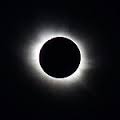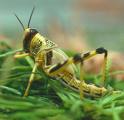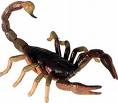
| Next | Previous | Index | Tellout Home |
37. Destroyer Locust Demon
Revelation 9.7-11
"The locusts looked like horses prepared for battle. On their heads, they wore something like golden crowns, and their faces resembled human faces. Their hair was like women's hair, and their teeth were like lions' teeth. They had iron breastplates, and their wings' sound was like many horses' and chariots' thundering into battle. They had stinger tails like scorpions and the power to torment people for five months. They had as king over them the Abyss Angel, whose name is 'Abaddon' in Hebrew and 'Apollyon' in Greek. (Revelation 9.7-11) ✞
Destroyer Locust Demon
 Revelation describes the destroyer locust demon in vivid detail. Their golden crowns indicate their power to succeed like kings. Their faces may refer to their human-like intelligence. Locusts move like an army directed by their leader. "People have dug trenches, lit fires, and even fired cannons to stop them but without success. They advance in a regular column that climbs hills, enters houses, and leaves scorched earth behind them. There is no more destructive visitation than a destroyer locusts' plague." ✞
Revelation describes the destroyer locust demon in vivid detail. Their golden crowns indicate their power to succeed like kings. Their faces may refer to their human-like intelligence. Locusts move like an army directed by their leader. "People have dug trenches, lit fires, and even fired cannons to stop them but without success. They advance in a regular column that climbs hills, enters houses, and leaves scorched earth behind them. There is no more destructive visitation than a destroyer locusts' plague." ✞
Demonic Leader
 John of Patmos sees the terrible devastation of the destroyer locust demons. They are different and far more destructive than any earthly insect he may have seen before. The leader is called "The Destroyer." John of Patmos gives us the Hebrew term "Abaddon," meaning "destruction." In Greek, the same word is "Apollyon," but it is not the usual word used to translate "Abaddon." In Aramaic, "Abaddon" means "destruction or ruin." Both names represent "The Destroyer, the Destruction Place or Destruction" and refer to "Hell," Satan's abode. John of Patmos' wordplay may show that the Greek and Roman deity Apollo worshippers serve the destroyer locust demon. Emperor Domitian (51-96 AD) believed he was an enlightened leader destined to guide the Roman Empire into a new brilliant era. Domitian also thought of himself as Apollo's reincarnation. He was, however, a little mad. The play on words "Apollyon" and "Apollo" may also be John of Patmos's way of referring in a subtle way to the terrible evil of the worst Roman Emperor. ✞
John of Patmos sees the terrible devastation of the destroyer locust demons. They are different and far more destructive than any earthly insect he may have seen before. The leader is called "The Destroyer." John of Patmos gives us the Hebrew term "Abaddon," meaning "destruction." In Greek, the same word is "Apollyon," but it is not the usual word used to translate "Abaddon." In Aramaic, "Abaddon" means "destruction or ruin." Both names represent "The Destroyer, the Destruction Place or Destruction" and refer to "Hell," Satan's abode. John of Patmos' wordplay may show that the Greek and Roman deity Apollo worshippers serve the destroyer locust demon. Emperor Domitian (51-96 AD) believed he was an enlightened leader destined to guide the Roman Empire into a new brilliant era. Domitian also thought of himself as Apollo's reincarnation. He was, however, a little mad. The play on words "Apollyon" and "Apollo" may also be John of Patmos's way of referring in a subtle way to the terrible evil of the worst Roman Emperor. ✞
Swarm of Locusts
 The destroyer locust demon swarms produce darkness like a solar eclipse with the terrible devastation of all living things. Deadly locust swarms breed in desert places and then invade cultivated lands for food. These insects are usually about two inches long, with a wingspan of four to five inches. They belong to the household cricket and the grasshopper family. Locust swarms, however, can be a hundred feet deep and four miles long. The locust swarm's destructive power is almost beyond belief. ✞
The destroyer locust demon swarms produce darkness like a solar eclipse with the terrible devastation of all living things. Deadly locust swarms breed in desert places and then invade cultivated lands for food. These insects are usually about two inches long, with a wingspan of four to five inches. They belong to the household cricket and the grasshopper family. Locust swarms, however, can be a hundred feet deep and four miles long. The locust swarm's destructive power is almost beyond belief. ✞
Locusts Sounds
 Revelation's writer explains the many scorpion locusts' sounds. Some hiss, but most make crackling sounds like crickets by rubbing body parts against one another, known as "stridulation." Some scorpion locust sounds are like "the waters dashing in a mill-wheel" or a "great waterfall." They may roar like the 3,212 feet Angel Falls in Bolivar State, Venezuela, the world's highest uninterrupted waterfall. Witnesses describe millions of locusts eating like "a prairie fire crackling." The sound of marching scorpion locusts sometimes resembles "heavy rain falling on a distant forest." When the destroyer locust swarms leave an area, the land looks scorched like after a wildfire. Not one green plant, grass blade, or any vegetation remains. Locusts even strip the tree's bark. An Algiers locust plague caused the famine of 1866, in which 200,000 people perished. ✞
Revelation's writer explains the many scorpion locusts' sounds. Some hiss, but most make crackling sounds like crickets by rubbing body parts against one another, known as "stridulation." Some scorpion locust sounds are like "the waters dashing in a mill-wheel" or a "great waterfall." They may roar like the 3,212 feet Angel Falls in Bolivar State, Venezuela, the world's highest uninterrupted waterfall. Witnesses describe millions of locusts eating like "a prairie fire crackling." The sound of marching scorpion locusts sometimes resembles "heavy rain falling on a distant forest." When the destroyer locust swarms leave an area, the land looks scorched like after a wildfire. Not one green plant, grass blade, or any vegetation remains. Locusts even strip the tree's bark. An Algiers locust plague caused the famine of 1866, in which 200,000 people perished. ✞
Locust Kinds
 The Old Testament mentions many "locust types." Joel 2.25 lists several Hebrew scorpion locusts' names. "I will repay you the years that the locusts have eaten, the "great locust," the "young locust," the other locusts or "the cutter" and the locust swarm, the great army that I sent among you." The "great locust" is known as "the hopper," the "young locust" as "the destroyer," and then there is the "swarming locust." The precise meanings of the Hebrew words used here for locusts are uncertain, but translators try to differentiate between them. The King James Version of this Joel 3.25 passage reads, "And I will restore to you the years that the locust hath eaten, the cankerworm, the caterpillar, and the palmerworm, my great army which I sent among you." ✞
The Old Testament mentions many "locust types." Joel 2.25 lists several Hebrew scorpion locusts' names. "I will repay you the years that the locusts have eaten, the "great locust," the "young locust," the other locusts or "the cutter" and the locust swarm, the great army that I sent among you." The "great locust" is known as "the hopper," the "young locust" as "the destroyer," and then there is the "swarming locust." The precise meanings of the Hebrew words used here for locusts are uncertain, but translators try to differentiate between them. The King James Version of this Joel 3.25 passage reads, "And I will restore to you the years that the locust hath eaten, the cankerworm, the caterpillar, and the palmerworm, my great army which I sent among you." ✞
Locust Characteristics
 Each locust's characteristics also account for its name. Strong's Concordance calls one locust type "gazam" another the "gnawing locust." The "shearer" describes how they cut down all living vegetation in its path. Another named "arbel," or "the swarmer" represents its immense numbers. Another is called "hasil," the "finisher," which pictures the swarm's utter devastation left behind after they had eaten. Some locusts are named "solam," the "swallower," or the "annihilator." "Hargol," meaning the "galloper," describes the scorpion locust's rapid progress like a horse across the land. "Tzelatzel," the "Creeker," explains the particular sound this variety makes. In Revelation, the demonic locusts do not attack the vegetation but advance against people without God's forehead seal. The locust's king is Satan. ✞
Each locust's characteristics also account for its name. Strong's Concordance calls one locust type "gazam" another the "gnawing locust." The "shearer" describes how they cut down all living vegetation in its path. Another named "arbel," or "the swarmer" represents its immense numbers. Another is called "hasil," the "finisher," which pictures the swarm's utter devastation left behind after they had eaten. Some locusts are named "solam," the "swallower," or the "annihilator." "Hargol," meaning the "galloper," describes the scorpion locust's rapid progress like a horse across the land. "Tzelatzel," the "Creeker," explains the particular sound this variety makes. In Revelation, the demonic locusts do not attack the vegetation but advance against people without God's forehead seal. The locust's king is Satan. ✞
Scorpion's Tail Stings
 The Revelation scorpions' attacks last for five months, which is the total life span of a "locust." Five months represents birth, through the larval stage, to death. A whole scorpion generation in this Revelation passage launches simultaneously. Revelation's destroyer locust demons have the scorpion's power added to them. The scorpion is like an undersized lobster with large claws to clutch its prey. Unlike the lobster, its long tail curves up over its back and head. A curved rear claw and a "telson stinger" inject poison to paralyze its captive. Lobsters, shrimps, prawns, and horseshoe crabs also have the scorpion's claw. ✞
The Revelation scorpions' attacks last for five months, which is the total life span of a "locust." Five months represents birth, through the larval stage, to death. A whole scorpion generation in this Revelation passage launches simultaneously. Revelation's destroyer locust demons have the scorpion's power added to them. The scorpion is like an undersized lobster with large claws to clutch its prey. Unlike the lobster, its long tail curves up over its back and head. A curved rear claw and a "telson stinger" inject poison to paralyze its captive. Lobsters, shrimps, prawns, and horseshoe crabs also have the scorpion's claw. ✞
Deathstalker Scorpion
 Deathstalker Scorpion's stings are still one of Palestine's scourges. This scorpion is up to six inches long, and its claw strikes and secretes poison into its victim. They live in wall cracks and under almost every stone. Near Eastern campers lift and examine rocks before pitching their tent if a "Deathstalker Scorpion" or the "Palestine Yellow Scorpion" is beneath. A scorpion's sting is worse than a hornet bite and is not necessarily fatal, but it can, in some instances, kill a human being. Only two of 1,500 worldwide scorpion species in Israel and Brazil have venom to kill an adult human being. ✞
Deathstalker Scorpion's stings are still one of Palestine's scourges. This scorpion is up to six inches long, and its claw strikes and secretes poison into its victim. They live in wall cracks and under almost every stone. Near Eastern campers lift and examine rocks before pitching their tent if a "Deathstalker Scorpion" or the "Palestine Yellow Scorpion" is beneath. A scorpion's sting is worse than a hornet bite and is not necessarily fatal, but it can, in some instances, kill a human being. Only two of 1,500 worldwide scorpion species in Israel and Brazil have venom to kill an adult human being. ✞
People Wishing to Die
 The pain caused by the scorpion's sting is so bad that victims are in terrible agony. Job 3.21 speaks of the supreme misery of those "who long for death that does not come, who search for it more than for hidden treasure." Jeremiah 8.3 also tells of the day when people "will prefer death to life." A Roman orator, Cornelius Gallus in BC 70-26, adds about the scorpion sting. "Worse than any wound is to wish to die and yet not be able to do so." ✞
The pain caused by the scorpion's sting is so bad that victims are in terrible agony. Job 3.21 speaks of the supreme misery of those "who long for death that does not come, who search for it more than for hidden treasure." Jeremiah 8.3 also tells of the day when people "will prefer death to life." A Roman orator, Cornelius Gallus in BC 70-26, adds about the scorpion sting. "Worse than any wound is to wish to die and yet not be able to do so." ✞
"Destroyer Locust Demons"
by Ron Meacock © 2021
| ^Top Page | Next | Previous |